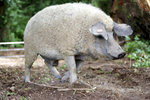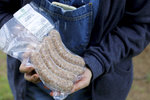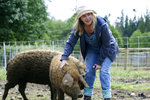


KINGSTON — Tania Issa's pigs always look sheepish.
Not abashed, mind you, just woolly.
Her 18 mangalitsa hogs are covered from snout to hoof in a mat of curly hair, which gives them the appearance of being fluffy. The wool is actually coarse and wiry to the touch, but that doesn't keep Issa from indulging her pigs with long belly scratches.
"I could spend hours and hours hanging out with them, they're just so happy," she said on a recent visit to the Jefferson Point farm Issa owns with her husband Antoine.
Issa is one of the few Washington farmers raising pure mangalitsas, a heritage breed developed in Hungary, where the pigs are considered a national treasure.
Once numbering in the millions, mangalitsas nearly went extinct during Hungary's communist era, according to "The Mangalitsa Pig," a book published to promote the breed. A concerted breeding effort has returned the furry pigs to prominence.
It helps that mangalitsas are exceptionally tasty.
Cooks prize the hogs' meat for its flavor and high lard content. Cuts of the meat are marbled and ringed in layers of snowy white fat. Foodies celebrate the health benefits of mangalitsa (the lard is rich in monounsaturated fat, considered a good fatty acid).
"The mangalitsa is totally different, you can't compare it to other pork," said Barbara Meyer zu Altenschildesche, who raises mangalitsas in the Netherlands and helped establish the breed in the United States. "You don't need salt and you don't need pepper. It's delicious by itself."
Issa sells whole and half pigs, and markets smaller cuts like chops, bacon and brats, at her Kingston Mercantile & Marine store. Chefs at North Kitsap farm-to-table restaurants Mossback and Butcher & Baker have incorporated meat from Issa's pigs in their recipes.
Delectable as they may be, Issa was first drawn to mangalitsas for a different reason. The Kingston resident, whose background is in bio-medical research, is fascinated by animals that can both be harvested and used to help manage land.
While browsing through papers, Issa stumbled across an article on mangalitsas being deployed to eradicate invasive plants from wetlands in Europe.
"I read about them and I fell in love," she said.
Issa bought her first mangalitsas from a breeder in California last year and introduced them to her small farm overlooking Appletree Cove. The pigs promptly cleared her fields of Scotch broom, devouring the invasive plants whole.
Unlike commercial meat hogs, mangalitsas add weight gradually. Issa will let her pigs grow for up to 18 months before harvest, when they typically weigh about 300 pounds.
She feeds the mangalitsas a mix of native grass, nuts and organic feed. The pigs are often let out to forage in the shady grove of maples outside their pens, grunting happily as they dig for roots.
"You are what you eat, and that's all the more true with these guys," she said. "If we were feeding them slop, they wouldn't taste the way they taste."
The pigs' endearing character makes harvest time bittersweet. Most of the hogs are outgoing and friendly. They trotted across their pens to greet visitors on a sunny afternoon last week. One lolled against Issa's legs as she scratched behind its floppy ears.
Zach Finley, who helps care for the hogs, sometimes takes piggyback rides on Hanzir, a 500-pound mangalitsa boar.
"They're really fun to work with," he said. "They each have their own personality."